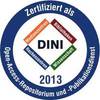Preview |
PDF, English
- main document
Download (2MB) | Lizenz:  Creative Commons Attribution 4.0 Creative Commons Attribution 4.0
|
Abstract
Peer review has become a dominant practice in scientific publishing [1]. It plays an essential role in the ability to trust scientific research [2]. However, the practice of peer review has been receiving more and more criticism, highlighting the challenges it faces. These include – but are not limited to – review and publication speed, finding (good) reviewers, review bias, and also fraudulent reviews.
The scientific community has actively reflected on these challenges and numerous suggestions for improvement have been proposed. Among the new developments aimed at improving the peer review process have been (i) publishing preprints and subsequent post-publication open peer review [1], (ii) providing formal recognition for reviewers [1] as well as (iii) requiring supplementary material in the form of FAIR research objects.
Some of these practices have already been implemented in one form or another by major publishers like PLOS or F1000Research, showing that the peer review landscape is changing. We would like to present our own experience with pushing peer review forward in the independent, scholarly-led journal ing.grid founded in 2021. ing.grid is a diamond OA journal for FAIR data management in engineering sciences that accepts manuscripts as well as software and data submissions. To improve the review process, we have implemented a post-publication open peer review process that aims for fast publication of the first version of the submission as a preprint and ultimately lead to fairer, high quality reviews. The principles of FAIRness and Open Science are reflected in the guidelines, as we require the supplementary material, especially the associated research objects like code and data, to be FAIRly available whenever relevant. Last but not least, we are aware of the need to provide formal recognition for reviewers, and so we provide review certificates for our reviewers and give them the option to submit their reviews under their name, optionally linked with their ORCID, or anonymously.
Our submission will show the mechanism of the open peer review process in ing.grid and reflect on how well it works in practice based on the existing publications. We will outline the problems that we are facing and how we are planning to address them in the near future.
References: [1] Central, BioMed (2017). What might peer review look like in 2030?. figshare. Journal contribution. https://doi.org/10.6084/m9.figshare.4884878.v1 [2] Preston, Andrew (2017): The Future of Peer Review. In: Scientific American, 09.08.2017. Available online under https://www.scientificamerican.com/blog/observations/the-future-of-peer-review/, last checked on 24.09.2024.
| Document type: | Conference Item |
|---|---|
| Place of Publication: | Heidelberg |
| Date Deposited: | 28 Mar 2025 13:25 |
| Date: | 2025 |
| Number of Pages: | 1 |
| Event Dates: | 12.03.2025 - 14.03.2025 |
| Event Location: | Universität Heidelberg |
| Event Title: | E-Science-Tage 2025 |
| Faculties / Institutes: | Service facilities > Computing Centre |
| DDC-classification: | 004 Data processing Computer science |
| Collection: | E-Science-Tage 2025 |









